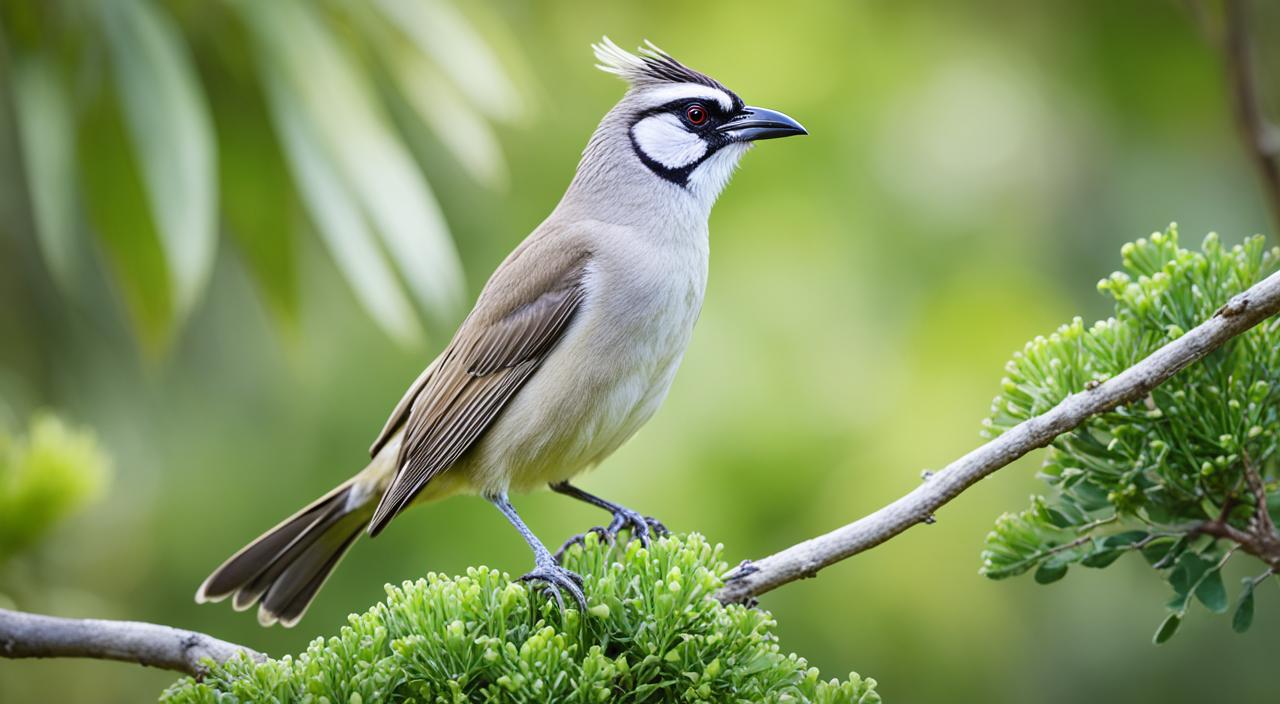The Crested Bellbird is a standout in Australia’s diverse bird world. It’s a medium-sized bird found only in mainland Australia. It’s known for its eye-catching looks and beautiful singing voice that fills the landscape.
This bird lives in various places, from the semi-arid coasts to the dry interior. You can find it in acacia shrublands, eucalypt woodlands, and chenopod plains.
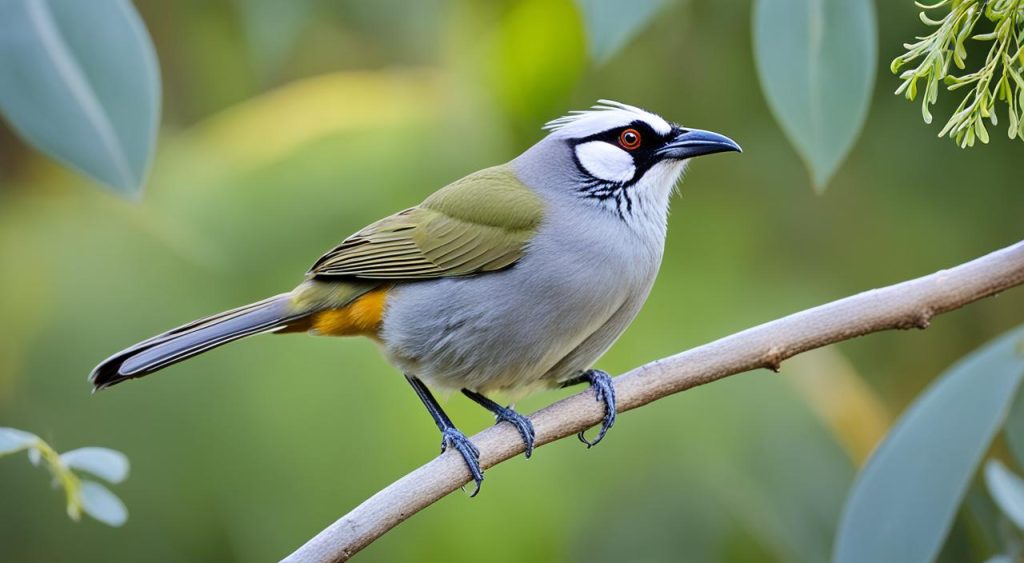
The adult male has a grey head, a raised black crest, and a white forehead and throat. It also has a black breast. Females and young birds are less colorful but still add to the bird’s unique look.
But what really makes the Crested Bellbird special is its song. It sings a beautiful, flowing song that can be heard far away. This song is a key part of the Australian outback’s sounds.
Introduction to the Crested Bellbird
The Crested Bellbird is a fascinating bird found in Australia. It’s an endemic Australian bird that has made its home in various landscapes. From the semi-arid coasts to the arid interiors, it’s a sight to behold. Its unique look and beautiful call have made it a favorite among bird lovers and nature fans.
Crested Bellbird Identification
Adult males of the Crested Bellbird stand out with their eye-catching features. They have a grey head with a high black crest, a white forehead, and throat, and a black breast. Their body is mostly grey or brown, and their eyes are a bright orange-red. Females and young birds are less colorful, with a smaller black crest.
Habitat and Distribution
The Crested Bellbird is an endemic Australian bird species found all over the country. They live in different places like acacia shrublands, eucalypt woodlands, and spinifex. They even live in chenopod (saltbush) plains or dunes. This lets them survive in both the semi-arid coastlines and the arid interior of Australia.

This bird mainly lives on the mainland of Australia. It’s not found in neotropical bird species areas. So, the Crested Bellbird is a special and interesting bird in the Australian bird world.
The Captivating Call of the Crested Bellbird
The Crested Bellbird’s song is a unique and enchanting sound heard across the Australian outback. It is famous for its smooth, deep notes that seem to glide through the air. The call starts softly and grows louder, creating a rhythm that can be heard far away.
At the core of its call are deep, bell-like tones mixed with smooth notes. This mix makes the Crested Bellbird’s call sound like it’s coming from nowhere. It’s hard to tell where the bird is calling from.
The song of the Crested Bellbird is a joy to hear and vital for avian communication and bird mating calls. These calls help the birds mark their territory, find mates, and talk with each other.
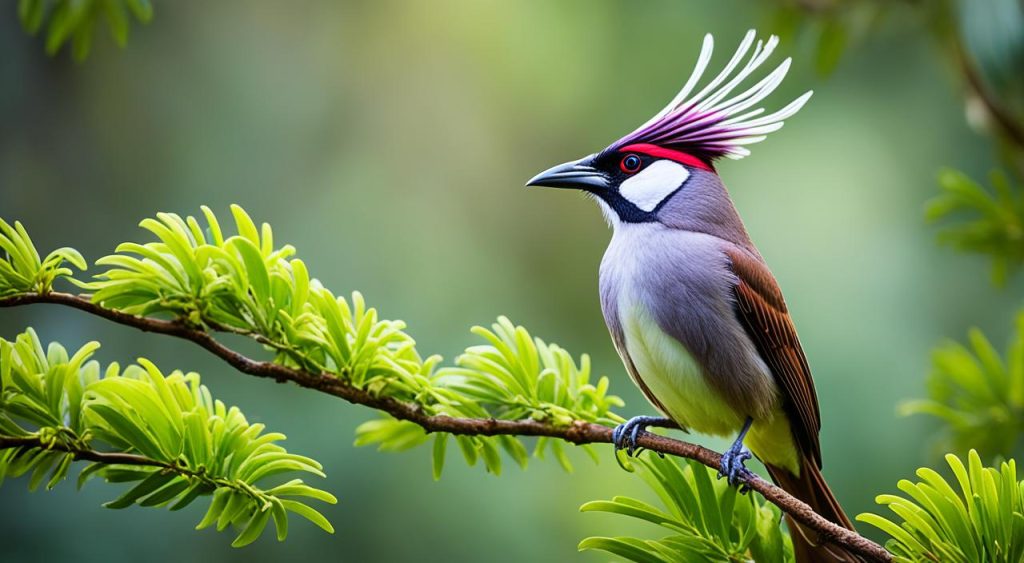
“The Crested Bellbird’s call is one of the most captivating and distinctive bird songs in Australia. It’s a true symphony of the outback.”
The Crested Bellbird’s skill in making ventriloquial bird calls adds to its charm. It can make its voice heard without showing where it is. This shows how well the bird has adapted and evolved.
Feeding and Foraging Habits
The Crested Bellbird is a skilled invertebrate forager that uses many food sources. It eats invertebrates, nectar, and fruit, showing its ability to live in ground-dwelling birds and mixed feeding flocks in Australia’s dry areas.
Diet and Feeding Behaviors
The Crested Bellbird forages in different ways. They hop and bounce on the ground to find food. They also call from high spots to help find food and work with others in their crested bellbird feeding behavior.
Invertebrates are a big part of their diet, coming from over 50 native plants. They also eat nectar from 139 plants and fruit from 97 plants. This variety helps them survive through the seasons.
| Food Source | Percentage of Feeding Observations | Number of Plant Species Utilized |
|---|---|---|
| Invertebrates | 56% | 50 |
| Nectar | 29% | 139 |
| Fruit | 15% | 97 |
The Crested Bellbird’s varied foraging and adaptability help it live in invertebrate foragers and ground-dwelling birds groups in Australia’s dry areas. It often joins mixed feeding flocks with other birds to find food.
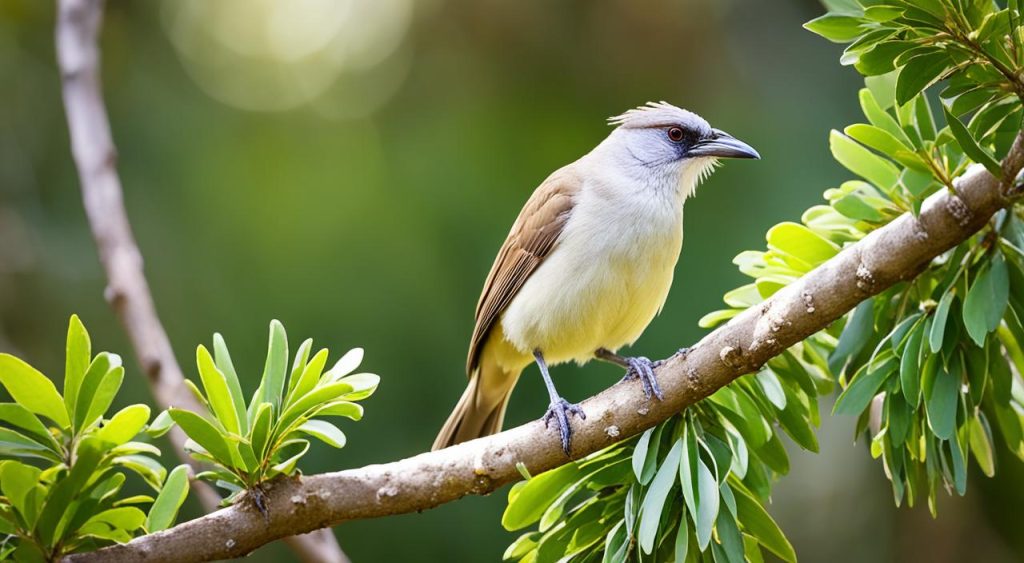
Crested Bellbird Nesting and Breeding
The crested bellbird has fascinating ways of nesting and breeding. From August to December, they form pairs and build a cup-shaped nest. They use twigs, bark, or leaves in a tree’s fork.
Both parents take turns incubating the eggs, which are usually one to four. The eggs stay under their care for about 16 days. After that, the crested bellbird chicks leave the nest after 12 days.
Breeding Season and Nest Construction
The breeding season for crested bellbirds is during the warm months, from August to December. They build a unique cup-shaped nest with twigs, bark, and leaves.
The nest is in a tree fork, offering safety and shelter for the crested bellbirds. Both parents help build the nest, making a cozy home for their young.
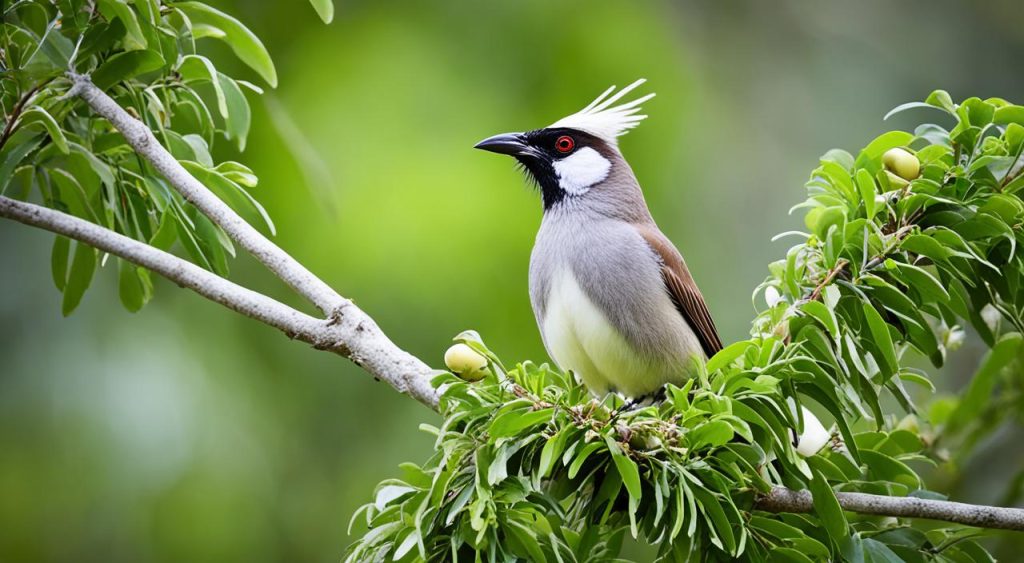
| Breeding Characteristic | Details |
|---|---|
| Breeding Season | August to December |
| Clutch Size | 1 to 4 eggs |
| Egg Color | White or tinged with blue |
| Incubation Period | 16 days |
| Nestling Period | 12 days |
The crested bellbird is a captivating bird. Its nesting and breeding behaviors are key to its survival and growth in Australia.
The Unique Crested Bellbird
The Crested Bellbird is a special bird found only in mainland Australia. It stands out with its black crest, white face, and black bib. These features make it unique among other birds.
Its song is also a highlight, sounding like ventriloquy. This sound is a key part of the Australian outback. The bird’s songs have been recorded for 34:12 minutes, showing its wide range.
| Statistic | Value |
|---|---|
| Number of foreground recordings | 47 |
| Number of background recordings | 59 |
| Maximum elevation recorded | 440 meters |
| Minimum elevation recorded | 120 meters |
| Average song duration | 1 minute and 10 seconds |
| Maximum song duration | 3 minutes and 43 seconds |
The Crested Bellbird is found only in mainland Australia. It’s most common in New South Wales, Western Australia, and Queensland. Each state has its own number of recordings.
This bird is not considered endangered, but its status varies by state. In Victoria, it’s near threatened due to habitat loss and predators.
The Crested Bellbird is a fascinating bird that plays a big role in Australia’s bird life. We should study and protect it to keep this unique bird around.
Threats and Conservation Status
The crested bellbird is a unique bird found in Australia. It faces many threats that have caused its numbers to drop. One big problem is the destruction and breaking up of its home due to land clearing.
This bird can’t easily adapt to losing and losing its natural spaces. Land clearing has made it hard for the crested bellbird to survive and find a mate.
Another threat is from invasive species like cats. These animals harm the bird’s chances of survival and breeding. Because of these threats, the crested bellbird is now seen as a threatened species in Victoria. This shows we need to act fast to save this special bird.
| Crested Bellbird Characteristics | Measurements |
|---|---|
| Size (length) | 190 – 230 mm (7.5 – 9.1 inches) |
| Wing span | 102 – 115 mm (4.0 – 4.5 inches) |
| Bill size | 18 – 24 mm (0.7 – 1.0 inches) |
| Weight | 55 – 75g (1.9 – 2.6 ounces) |
| Eggs per clutch | 2 – 4 eggs |
| Egg size | 27 x 20 mm (1.1 x 0.8 inches) |
| Incubation period | 16 days |
| Independent age | 12 days |
| Population trend | Decreasing |
| Conservation status | Least Concern |
| Threats | Habitat loss due to land clearing, predation from cats and foxes. |
We need to protect the crested bellbird’s home and fight against invasive species to save it. By tackling habitat fragmentation and invasive species impacts, we can help this crested bellbird. This will ensure its survival and keep the Australian bush healthy.
Indigenous Perspectives on the Crested Bellbird
The crested bellbird is a special bird native to Australia. It means a lot to the country’s indigenous people. They use names that sound like the bird’s call to describe it. This shows how closely tied the bird is to the traditional people who live there.
Traditional Names and Significance
In the Pitjantjatjara language, the bird is called “Panpanpalala.” This name echoes the bird’s deep, bell-like sounds. The Warlpiri people call it “Kanpanparlala,” which also reflects its deep, rich tones. These names show the cultural significance of the bird and the deep aboriginal knowledge about it.
For many indigenous groups, the crested bellbird is very important. Its call is tied to special rituals and stories. This shows the deep respect and understanding these communities have for the bird and its place in nature.
“The crested bellbird’s call is like the voice of our ancestors, guiding us through the land and reminding us of our connection to the natural world.”
– Excerpt from an interview with an Aboriginal elder from the Pitjantjatjara community.
Behavior and Social Dynamics
The crested bellbird is a fascinating bird from Australia. It has unique behaviors and social ways that make it stand out. These birds are territorial and work hard to protect their homes. They use songs and looks to show they own the area.
When it’s time to breed, crested bellbirds usually live in pairs. They work together to build nests and take care of their young. Both the male and female are key to raising their babies well.
These birds also hang out with other birds to find food together. Being part of a group helps them find food better and stay safe. It also lets them learn from each other and talk more.
Scientists have studied how crested bellbirds talk to each other. They found out these birds have different kinds of songs. Directed songs are for others, while undirected songs are for themselves. Each type of song uses different parts of the brain and releases dopamine.
Studying the crested bellbird teaches us a lot about bird communication and defending territory. These insights help us understand this special bird better. They also add to our knowledge of animal behavior in general.
Crested Bellbird Vocalizations
The crested bellbird is known for its beautiful, long song in the Australian outback. Its song has smooth notes with a deep “cow-bell” sound at the end. This makes it hard to find where the bird is calling from.
This bird can make its voice heard far and wide in the dry lands. It uses its song for many things like defending its area, finding a mate, and staying in touch with others. Researchers have studied over 100 recordings to learn about its different sounds.
Ventriloquial Quality and Range
The crested bellbird’s calls can be heard from half a kilometer away. This shows how good it is at making sounds that travel far. These sounds help the bird stay connected with others and protect its territory in the wide open spaces.
“The crested bellbird’s song is a true marvel of nature, captivating all who hear it with its fluid, resonant notes that seem to float effortlessly across the outback.”
Scientists have recorded the crested bellbird’s sounds in many places across Australia. They recorded it at different heights and times of day. This shows how well the bird can communicate over a wide area.
Bellbird Adaptations to Arid Environments
The crested bellbirds of Australia live in the desert and have special ways to survive. These crested bellbird adaptations help them save water, keep their body temperature right, and find food in the dry desert.
They know how to find and use little water they can. They go to places with water and know where to look for it. They also have special ways to save water by making their urine strong and losing less water through their skin and breathing.
Keeping cool is very important for these birds. They find shade, breathe fast, and change how thick their feathers are to stay cool. Their special calls might help them talk to each other and find their way in the desert.
Finding food is also a big challenge for these birds. They have special beaks and ways to eat to get by on what little food is there. They eat things like insects, seeds, and berries.
Learning about the behavioral and physiological adaptations of the crested bellbird shows us how it has adapted to live in the tough desert of Australia. It’s amazing how this bird has made its home in such a harsh place.
Ecological Importance of the Crested Bellbird
The Crested Bellbird is unique to mainland Australia. It plays a key role in the country’s ecosystems. This bird helps with seed dispersal, pest control, and nutrient cycling, making it a vital part of biodiversity.
Studies show the Crested Bellbird’s impact on northern Australia’s ecosystems. It’s important for the local environment’s health and balance.
This bird is threatened in some areas, like Victoria. This makes it a key indicator of habitat health. Conservation efforts aim to protect it, recognizing its role in the ecosystem.
The Crested Bellbird helps by spreading seeds and controlling insects. This shows its importance in Australia’s ecosystem.
Research suggests weather, not climate, affects the Crested Bellbird’s distribution. This highlights the need to understand its ecological needs better. As it adapts to its dry environment, it offers insights into Australia’s ecological health.
FAQ
What is the distinctive appearance of the Crested Bellbird?
The adult male Crested Bellbird has a grey head with a raised black crest. It also has a white forehead and throat, and a black breast. Females and young birds are less colorful, with a smaller, unraised crest.
Where is the Crested Bellbird found?
This bird is found in mainland Australia. It lives from the semi-arid coast to the arid interior. It likes acacia shrublands, eucalypt woodlands, spinifex, and chenopod plains or dunes.
What is distinctive about the Crested Bellbird’s song?
Its song has repeated, resonant notes with a deep “cow-bell” tone at the end. This makes it hard to find the bird by sound alone.
What does the Crested Bellbird feed on?
It eats invertebrates and some seeds. It forages on the ground or in low shrubs. Sometimes, it joins other birds like Chestnut-rumped Thornbills and Red-capped Robins to eat.
How does the Crested Bellbird breed?
It makes pairs for breeding and builds a nest in a tree fork. The nest is made of twigs, bark, or leaves. Both parents incubate the eggs, which are usually one to four.
What are some threats to the Crested Bellbird?
Its home is being destroyed by land clearing, and cats prey on it. This has made it a threatened species in Victoria.
How do indigenous Australians describe the Crested Bellbird?
Indigenous Australians call it “Panpanpalala” in Pitjantjatjara and “Kanpanparlala” in Warlpiri. This shows its importance in their culture and connection to the land.
How does the Crested Bellbird’s behavior and social dynamics?
It is usually alone or in pairs, but sometimes joins others to eat. It is territorial and defends its home. It also works with its mate on nesting and caring for their young.
What adaptations does the Crested Bellbird have for its arid habitat?
It has adapted to live in dry areas. It conserves water, regulates its body temperature, finds food in unique ways, and makes sounds to communicate and find its way.
What is the ecological importance of the Crested Bellbird?
This bird is key to Australia’s ecosystems. It helps with seed dispersal, controlling pests, and cycling nutrients. Its threat status shows how important its habitats are to the environment.
